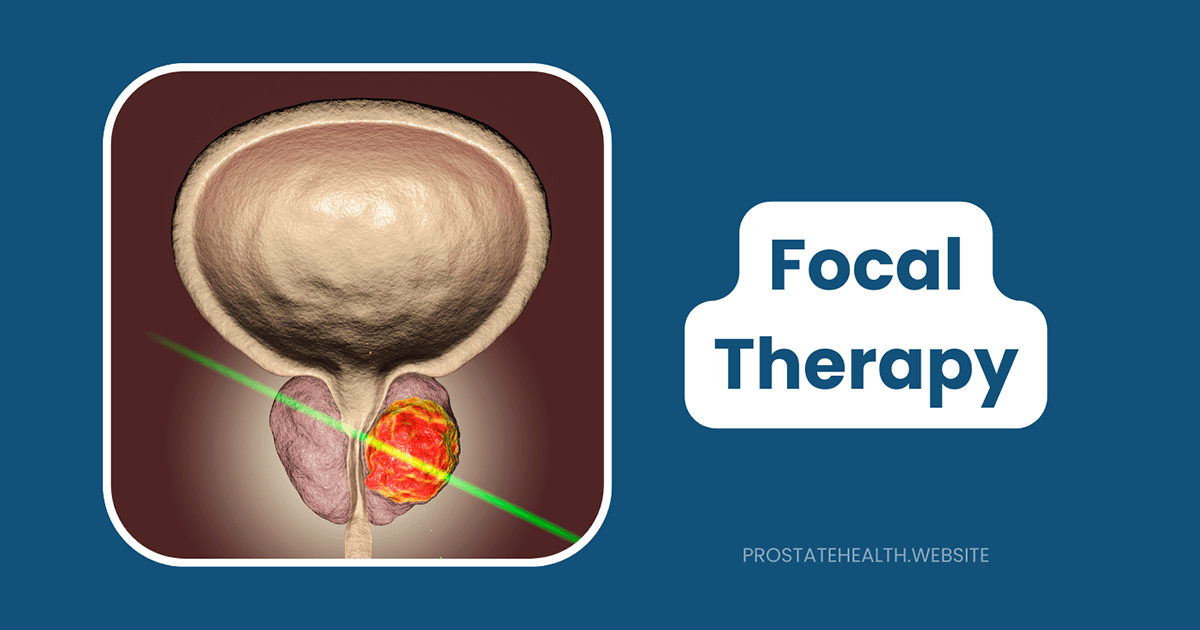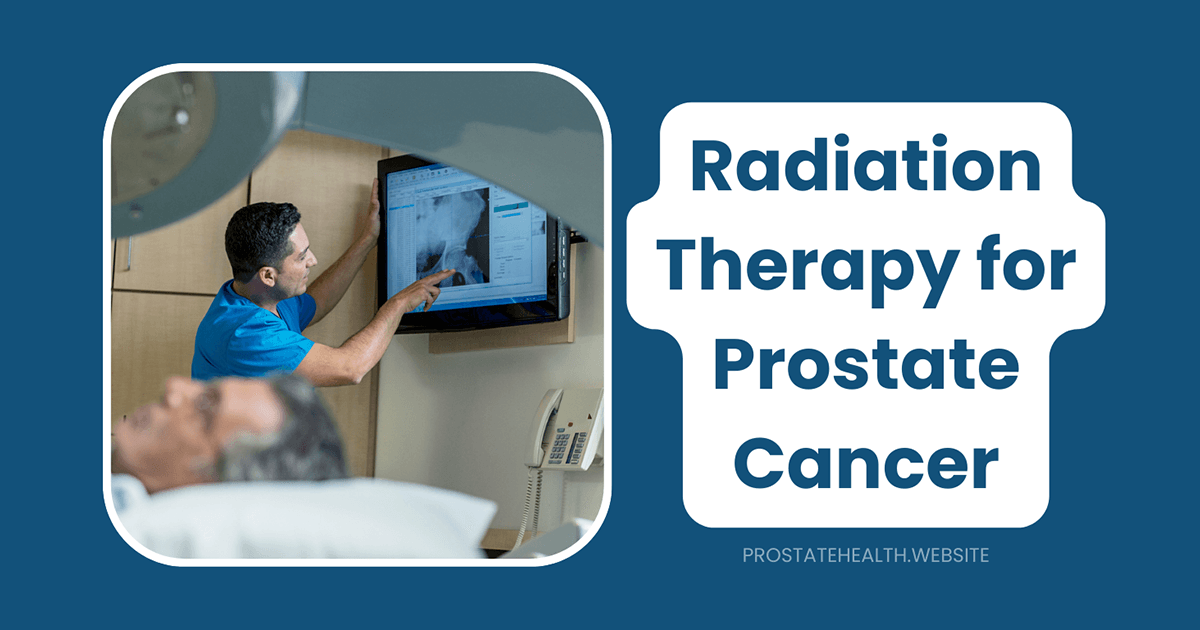Focal Therapy Options for Localized Prostate Cancer: The Middle Ground Approach

When men are diagnosed with localized prostate cancer, they’ve traditionally faced a difficult choice: aggressive treatment with potential side effects or active surveillance with the anxiety of living with untreated cancer. But what if there was a middle ground?
Enter focal therapy – an approach that targets just the cancerous areas while preserving the rest of the prostate gland. As someone who’s spent years advocating for men’s health, I’ve seen firsthand how these emerging options are changing the conversation around prostate cancer treatment.
In this comprehensive guide, we’ll explore the various focal therapy options available in 2025, who makes an ideal candidate, and what the latest research tells us about outcomes.
The Focal Therapy Concept: Treating the Cancer, Not the Whole Gland
Traditional prostate cancer treatments like radical prostatectomy (surgical removal of the entire prostate) and radiation therapy treat the whole gland. While effective at controlling cancer, these approaches can lead to significant side effects, including:
- Urinary incontinence (5-20% of patients)
- Erectile dysfunction (30-70% of patients)
- Bowel problems (particularly with radiation)
Focal therapy takes a different approach, treating only the area of the prostate containing significant cancer while preserving the rest of the gland and surrounding structures. This “male lumpectomy” concept is similar to how breast cancer treatment evolved from mastectomy to lumpectomy for appropriate candidates.
The goal? To provide effective cancer control with fewer side effects and better quality of life.
Who Is a Good Candidate for Focal Therapy?
Not every man with prostate cancer is suitable for focal therapy. The ideal candidate typically has:
- Localized disease: Cancer confined to the prostate without evidence of spread
- Intermediate-risk disease: Primarily Gleason Grade Group 2-3 (Gleason score 3+4 or 4+3)
- MRI-visible tumor: A lesion that can be clearly seen on multiparametric MRI
- Confirmed by targeted biopsy: MRI-guided biopsy showing cancer in the suspicious area
- Unifocal or unilateral disease: Cancer limited to one area or one side of the prostate
- Life expectancy >10 years: To benefit from cancer control while avoiding side effects
- PSA <20 ng/mL: Ideally <10 ng/mL
According to the 2025 consensus from the Focal Therapy Society, patients with low-volume, intermediate-risk disease stand to gain the most from focal approaches. Why? These men have cancer significant enough to warrant treatment but may not need the aggressive approach used for high-risk disease.
Dr. Samir Taneja, a leading urologist specializing in focal therapy, explains: “The ideal patient has a visible lesion on MRI that corresponds with a biopsy-proven, clinically significant cancer, but without evidence of widespread disease throughout the gland.”
Available Focal Therapy Options in 2025
Several technologies are currently used for focal therapy, each with unique characteristics. Let’s explore the most established options:
1. High-Intensity Focused Ultrasound (HIFU)
How it works: HIFU uses focused sound waves to heat tissue to temperatures between 80-90°C, causing precise coagulative necrosis (tissue death) in the targeted area.
Procedure details: Performed under general or spinal anesthesia, typically as an outpatient procedure. An ultrasound probe inserted in the rectum delivers the treatment, often with MRI fusion for precise targeting.
Best for: Posterior tumors (closer to the rectum) and smaller prostates (<40cc).
Outcomes: Studies show 5-year failure-free survival rates of approximately 88% and metastasis-free survival rates of 95%. In-field recurrence rates range from 0-36%.
Pros:
- Highly precise
- Excellent preservation of erectile function (75-95%)
- Very low rates of urinary incontinence (<1%)
- Can be repeated if necessary
Cons:
- Less effective for anterior tumors
- May not be suitable for very large prostates
- Potential for temporary urinary symptoms
2. Cryotherapy (Cryoablation)
How it works: Cryotherapy uses extreme cold (temperatures below -40°C) to freeze and destroy cancer cells. Multiple freeze-thaw cycles ensure complete cell death in the target area.
Procedure details: Performed under anesthesia, with thin needles inserted through the perineum (area between scrotum and rectum) into the prostate. A warming catheter protects the urethra.
Best for: Anterior tumors and larger prostates. Can treat areas near the urethra with appropriate precautions.
Outcomes: Studies report 3-year failure-free survival rates of approximately 90.5%. In-field recurrence rates range from 6-24%.
Pros:
- Effective for anterior tumors
- Well-established technology with longer follow-up data
- Good cancer control rates
- Can treat larger areas if needed
Cons:
- Slightly higher rates of erectile dysfunction (0-31%)
- Urinary retention in 1-17% of patients
- Risk of urethral sloughing if warming catheter fails
3. Focal Laser Ablation (FLA)
How it works: Laser fibers deliver precise thermal energy to the tumor, causing cell death through coagulative necrosis.
Procedure details: Often performed under MRI guidance for real-time temperature monitoring, with laser fibers inserted through the perineum.
Best for: Small, well-defined lesions, particularly in sensitive locations where precision is critical.
Outcomes: Studies show 89-96% absence of disease in the treated area at 12 months, though overall recurrence rates can be higher (up to 37% anywhere in the prostate).
Pros:
- Extremely precise
- MRI-guided with real-time temperature feedback
- Minimal collateral damage
- Low complication rates
Cons:
- Limited to smaller tumors
- Higher rates of incomplete treatment
- Less long-term data available
4. Irreversible Electroporation (IRE/NanoKnife)
How it works: Short pulses of high-voltage electrical current create nanopores in cancer cell membranes, triggering cell death while preserving surrounding structures like blood vessels and nerves.
Procedure details: Performed under general anesthesia with electrode needles placed through the perineum into the prostate under ultrasound or MRI guidance.
Best for: Tumors near critical structures like neurovascular bundles or the urinary sphincter, where preservation of these structures is crucial.
Outcomes: Studies report in-field recurrence rates of 12-35%, with 24% persistent cancer within the prostate in some series.
Pros:
- Non-thermal (preserves structural integrity of surrounding tissues)
- Potentially better nerve preservation
- Precise margins between treated and untreated tissue
- Promising for preserving erectile function
Cons:
- Newer technology with less long-term data
- Requires general anesthesia with muscle paralysis
- Higher cost than some alternatives
5. Photodynamic Therapy (PDT)
How it works: A photosensitizing drug is administered intravenously, which accumulates in cancer cells. When activated by specific wavelengths of light, it creates reactive oxygen species that destroy the cancer.
Procedure details: After drug administration, light-emitting fibers are inserted into the prostate to activate the drug in the target area.
Best for: Patients who may not be candidates for other focal therapies due to prostate size or tumor location.
Outcomes: Studies show a 25% in-field recurrence rate and conversion to radical therapy in 24% of patients (compared to 53% with active surveillance).
Pros:
- Can treat difficult locations
- Selective for cancer cells that absorb more of the photosensitizing agent
- Potentially less damage to surrounding structures
Cons:
- Temporary photosensitivity requiring sun avoidance
- Higher rates of erectile dysfunction (up to 38%)
- Urinary complications in up to 27% of patients
Comparing Outcomes: What Does the Research Show?
When evaluating focal therapy options, both cancer control and quality of life outcomes matter. Here’s what the latest research tells us:
Cancer Control Outcomes
A 2025 systematic review of 39 studies comparing different focal therapy modalities found:
- Short to medium-term cancer control: Most modalities show 75-90% freedom from clinically significant cancer in the treated area at 1-3 years
- Metastasis-free survival: Extremely high (95-100%) across all modalities at 5 years
- Need for additional treatment: 20-25% of patients require retreatment or conversion to radical therapy within 5 years
The Phase II trial using bipolar radiofrequency ablation (bRFA) showed a disease-free survival of 38% and clinically significant disease-free survival of 57% at a median follow-up of 79 months. Importantly, metastasis-free survival, cancer-specific survival, and overall survival rates were all 100%.
Functional Outcomes
Focal therapy generally shows excellent preservation of urinary and sexual function:
- Urinary continence: 95-100% of patients maintain pad-free continence
- Erectile function: Preservation rates range from 54-100% depending on the modality and pre-treatment function
- Recovery time: Most patients return to baseline urinary function within 12 months
A retrospective study comparing focal HIFU with robotic radical prostatectomy showed no significant difference in treatment failure at 3 years, but significantly better recovery of continence and erectile function with HIFU.
The Patient Experience: What to Expect
If you’re considering focal therapy, here’s what the typical patient journey looks like:
1. Comprehensive Evaluation
- Multiparametric MRI: To identify and characterize suspicious lesions
- MRI-targeted biopsy: To confirm cancer in the suspicious area
- Systematic biopsy: Often still recommended to check for cancer in MRI-negative areas
- Genomic testing: Sometimes used to better understand cancer aggressiveness
2. Treatment Planning
- Detailed mapping: Precise localization of the tumor and planning of treatment margins (typically 5-10mm beyond visible tumor)
- Discussion of options: Selection of the most appropriate focal therapy based on tumor location, size, and other factors
- Pre-procedure preparation: Instructions regarding medications, fasting, and other preparations
3. The Procedure
Most focal therapies are performed as outpatient procedures or with a single overnight stay. Depending on the modality, you may receive:
- General anesthesia or spinal anesthesia
- Placement of a urinary catheter (temporary)
- The actual treatment, lasting 1-3 hours
4. Recovery and Follow-up
- Short-term recovery: Most men return to normal activities within days to a week
- PSA monitoring: Regular PSA tests to track response
- Follow-up MRI: Typically at 6-12 months
- Confirmatory biopsy: Often recommended at 12 months to verify treatment success
Comparing Focal Therapy to Traditional Approaches
To put focal therapy in context, let’s compare it to the traditional options:
| Aspect | Radical Treatment | Focal Therapy | Active Surveillance |
| Cancer control | Excellent long-term | Good medium-term | Variable (depends on progression) |
| Urinary continence | 80-95% | 95-100% | 100% |
| Erectile function | 30-70% | 70-95% | 100% |
| Recovery time | Weeks to months | Days to weeks | None |
| Need for retreatment | Low (5-10%) | Moderate (20-25%) | High (30-50% eventually need treatment) |
| Psychological burden | Initial treatment anxiety | Moderate | Ongoing monitoring anxiety |
The ProtecT trial, which followed men for 15 years after diagnosis, showed that disease-specific mortality remains low regardless of initial management approach. This suggests that for appropriately selected patients, focal therapy may offer a reasonable balance between treatment and quality of life.
The Current Debate: Is Focal Therapy “Prime Time” Ready?
The 2025 American Urological Association (AUA) Annual Meeting featured a debate titled “Focal Therapy for Prostate Cancer: Prime Time or Not?” This reflects the ongoing discussion in the medical community.
Proponents argue that:
- Focal therapy offers cancer control with fewer side effects
- Modern imaging and biopsy techniques allow for accurate patient selection
- Medium-term outcomes are promising
- Patient demand for less invasive options is growing
Critics counter that:
- Long-term comparative data with traditional treatments is lacking
- Prostate cancer is often multifocal, raising concerns about untreated areas
- Patient selection criteria aren’t standardized
- Insurance coverage remains inconsistent
The 2022 AUA/ASTRO guidelines recommend focal therapy for low- and intermediate-risk prostate cancer but not for high-risk cases. They also note the lack of high-quality comparative data.
Making the Decision: Is Focal Therapy Right for You?
If you’re considering focal therapy, here are some important questions to discuss with your doctor:
- Is my cancer truly localized? Comprehensive imaging and biopsy are essential.
- What’s my Gleason score and tumor volume? These factors help determine if you’re an ideal candidate.
- Which focal therapy option is best for my specific situation? The location and characteristics of your tumor matter.
- What’s the experience level of my treatment team? Focal therapy requires specialized expertise.
- What will my follow-up protocol look like? Ongoing monitoring is crucial.
- What are my options if focal therapy doesn’t work? Understanding your “Plan B” is important.
- Will my insurance cover this treatment? Coverage varies widely.
The Future of Focal Therapy
Focal therapy continues to evolve, with several exciting developments on the horizon:
- Advanced imaging techniques: Improved MRI protocols and PSMA PET imaging are enhancing our ability to detect and characterize prostate cancer.
- Artificial intelligence: AI algorithms are helping to better identify candidates and plan treatments.
- Combination approaches: Some centers are exploring combining focal therapy with immunotherapy or targeted drugs.
- Ongoing clinical trials: The VAPOR 2 pivotal study is currently enrolling 325 men to evaluate focal therapy using water vapor ablation for intermediate-risk prostate cancer.
Conclusion: A Personalized Approach
Focal therapy represents a middle ground in prostate cancer treatment – not as aggressive as radical therapy but more interventional than active surveillance. For the right patient, it offers a chance to control cancer while preserving quality of life.
As with all prostate cancer decisions, the choice should be personalized based on your specific cancer characteristics, overall health, age, and personal preferences. Working with a multidisciplinary team experienced in all treatment options will help ensure you make the best decision for your situation.
Remember that while focal therapy is promising, it’s still evolving. Ongoing monitoring is essential, and some men may eventually need additional treatment. The good news is that even if focal therapy doesn’t provide a permanent solution, it rarely burns bridges – other treatment options remain available if needed.
Have you or a loved one considered focal therapy for prostate cancer? What questions do you have about these approaches? Share your thoughts in the comments below.






